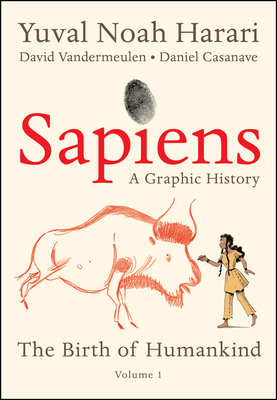
Adapting a monumental work like Sapiens: A Brief History of Humankind into a graphic novel is no small feat, yet Yuval Noah Harari, along with illustrator Daniel Casanave and adapter David Vandermeulen, manages to create an engaging and visually captivating journey through human evolution. Sapiens: A Graphic History, Volume 1 – The Birth of Humankind reimagines Harari’s sweeping exploration of history into a colorful, accessible, and thought-provoking experience that appeals to both young readers and adults.
The book condenses the first part of Harari’s original bestseller, focusing on the Cognitive Revolution the point in time when Homo sapiens began to outthink, outcommunicate, and ultimately outlive other human species. What makes this adaptation stand out is its creative use of narrative framing. Instead of a linear historical retelling, the story unfolds through a lively dialogue between Harari himself, a cast of fictional characters including a curious student and the memorable Professor Saraswati, and various prehistoric humans. This storytelling approach keeps the dense subject matter light, funny, and approachable without losing its intellectual spark.
The illustrations are stunning. Casanave’s art brings to life everything from ancient cave paintings to modern classrooms in vibrant detail, creating a seamless blend between past and present. The use of color, humor, and caricature adds warmth and wit, making complex ideas about evolution, myth, and human psychology easier to grasp. For readers who might have found the original Sapiens too heavy or abstract, this version transforms it into a visual adventure.
However, not everyone finds the adaptation flawless. Some critics, like Rama Rao, argue that the book sacrifices accuracy for accessibility. He points out several scientific omissions and oversimplifications, including a lack of detail on interbreeding between Neanderthals, Denisovans, and early humans, as well as minimal attention to mass extinction events. Rao also highlights cultural insensitivities, particularly in the portrayal of Professor Saraswati, who some readers feel is stereotyped. These are fair concerns, reminding us that simplifying complex science for a general audience can sometimes blur important nuances.
Yet many readers, like Rosh, see the book as a triumph. She praises its inclusivity and educational value, noting that it introduces Harari’s ideas in a way that is digestible for teens and young adults. Her parental note about mild nudity and adult themes is practical rather than censorious this is a book that treats its audience with respect, trusting readers to engage critically. For parents, it’s a matter of timing and context, not restriction.
Then there are readers like Ulysse, who take a more philosophical view. He finds Harari’s message darkly pessimistic: humans are portrayed as destructive gossipers whose talent for storytelling leads both to our greatness and our downfall. While this cynicism might not appeal to everyone, it’s undeniably part of Harari’s enduring appeal his ability to make readers question what it means to be human in the first place.
Ultimately, Sapiens: A Graphic History, Volume 1 succeeds in its mission. It makes history vivid, funny, and accessible while keeping Harari’s provocative questions intact. It’s not perfect, but it’s an imaginative and valuable addition to the Sapiens universe ideal for visual learners, young readers, or anyone curious about where we came from and how stories made us who we are.
If you’ve ever wanted to explore humanity’s origins in a way that’s as entertaining as it is enlightening, this book deserves a place on your shelf.
👉 Buy Sapiens: A Graphic History, Volume 1 – The Birth of Humankind on Amazon


